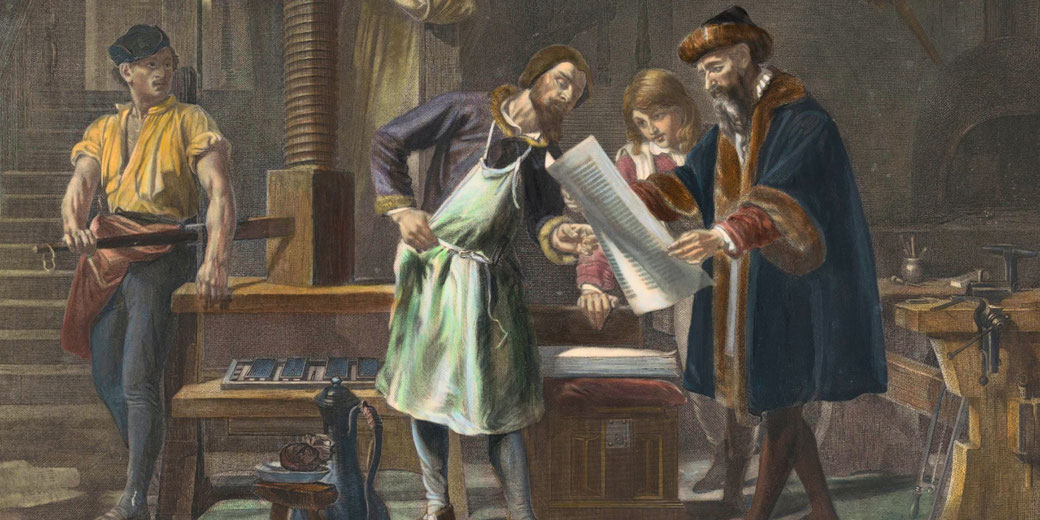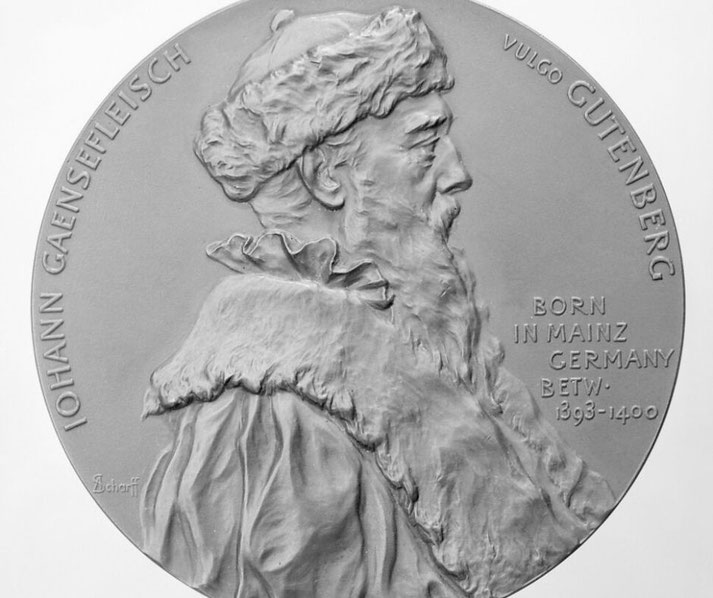Why the invention of the printing press changed the world forever

The invention of the printing press transformed how people accessed and shared knowledge. By removing the limits of hand-copied texts, it allowed information to spread quickly, cheaply, and to wider audiences than before.
Within a few decades, it had changed religion, education, science, and communication across Europe.
What was the printing press?
Johannes Gutenberg invented the first mechanical movable-type printing press in Europe around 1440 in the German city of Mainz, where he combined his experience as a goldsmith with existing technologies to create a reliable system to produce texts on a large scale.
Movable type had previously been developed in East Asia, most notably in Korea, where the metal-type Jikji was printed in 1377.
However, Gutenberg used metalworking techniques to design durable individual type blocks for each letter and punctuation mark, which could be reused and rearranged to form new lines of text across multiple pages.
He cast these using a punch and matrix system, which allowed for precise and consistent copying of characters.
Rather than develop a new pressing mechanism, Gutenberg adapted the screw press commonly used in winemaking and papermaking, and he modified it to apply even pressure across a sheet of paper laid over inked type.
He also formulated a thick, oil-based ink that adhered well to metal type and gave clearer prints than the water-based inks used by scribes.
This process resulted in clean, consistent impressions and allowed for hundreds of identical pages to be produced in the time it would have taken scribes to copy a single manuscript.
By the time he completed the Gutenberg Bible around 1455, he had demonstrated that machines could outperform hand-copying in both accuracy and speed, and this offered a new model for knowledge that could be widely copied in Europe.

Within fifty years of Gutenberg’s invention, print shops had opened in more than two hundred European cities.
Output rose as printers met growing demand, and historians estimate that by 1500, as many as twenty million books had been in circulation across the continent.
Some of the earliest printed texts included indulgence certificates, Latin grammars, books of Psalms, and ancient texts, as well as religious scripture.
As paper supplies increased and printing costs fell, literacy began to rise among tradespeople and merchants who had previously lacked access to written material.
As printers moved away from religious texts and expanded their collections to include medical treatises, law books, grammars, poetry, and classical works, they helped encourage a new reading public whose interest spanned many fields.
Early humanists such as Erasmus of Rotterdam and Thomas More found their works widely circulated in print, contributing to scholarly debate across Europe.
This meant that the printing press allowed scholars in different regions to read the same texts, comment on each other’s work, and build a shared body of knowledge, which encouraged standardisation in spelling and grammar.
The rise of books in local languages enabled people to read in their own language rather than rely on clergy or scholars to interpret Latin texts.
When the press made information accessible to the wider population, it shifted educational authority away from religious institutions and gave independent readers more control, and many of these readers began to question traditional teachings and propose alternative views.
Standard print also helped to make regional dialects more stable, which contributed to the formation of modern national languages.
Its role in the Protestant Reformation
When Martin Luther launched his public criticism of the Catholic Church in 1517, he did so in a society that the press had already transformed.
After posting his Ninety-Five Theses on the door of Wittenberg’s Castle Church, they had been reprinted and distributed across Germany within weeks, aided by printers who recognised both the controversy and the chance to make money from his ideas.
When Luther wrote in both Latin and German, he ensured that his works could circulate among theologians as well as the educated lay population.
His decision to translate the Bible into German proved particularly influential, since it allowed ordinary people to read scripture without clerical mediation.
Between 1518 and 1525, printers had produced more than six million copies of his writings, including pamphlets, sermons, essays, and biblical translations, many of which reached people who had never read religious material before.
Luther’s works accounted for a significant share of all German-language publications during that period, with some estimates suggesting nearly a third.
Short tracts and broadsheets proved easier to print and distribute than full-length books, and this made them the preferred format for spreading Protestant arguments.
Reformers used these pamphlets to challenge Church authority and to set out their own teachings in accessible language.
In addition to Luther, figures such as Philipp Melanchthon, Huldrych Zwingli, and John Calvin relied heavily on printing to promote their religious views.
Calvin's Institutes of the Christian Religion, which was first published in 1536, became a foundational text of Reformed Protestantism and circulated widely across Europe.
Illustrated woodcuts accompanied many of these printed works, which provided visual commentary that supported the messages for those who could not read and which strengthened the impact of the text for those who could.
Lucas Cranach the Elder, a close associate of Luther, created many of the most famous images, such as those in the Passional Christi und Antichristi (1521), which contrasted biblical virtue with papal corruption.
Artists mocked corrupt priests, exposed the sale of indulgences, and promoted images of biblical virtue, which gave powerful support to the written word.
These images spread reformist ideas outside literate circles and turned print into a tool for public support.

As the movement grew, printers across major German cities, as well as in Basel, Strasbourg, and Zurich, took advantage of the growing appetite for theological debate and religious reform.
The ability to print in large numbers allowed Protestant ideas to reach France, England, and the Low Countries within a few years.
William Tyndale’s English New Testament, first printed in 1526, was smuggled into England and became one of the earliest examples of vernacular Protestant scripture that defied censorship.
The Reformation became, in effect, the first movement in European history to use mass-produced print as a tool for public persuasion and religious mobilisation.
Efforts to silence dissent proved increasingly ineffective. Although secular and Church authorities attempted to control printed output through licensing, censorship, and punishment, they lacked the resources to monitor every printer or prevent the smuggling of prohibited works.
In many cities, local officials or wealthy patrons protected reformist printers, while secret presses operated in more hostile regions.
The spread out nature of the printing industry gave Protestant authors a platform from which they could argue, reply, and refute their opponents in real time.
This allowed theological disputes to play out publicly in a way that had never been possible during the manuscript period, and it meant that the Reformation evolved through open debate rather than secret discussion.
The Catholic Church's panicked response
Officials within the Catholic Church viewed the printing press as both a threat to doctrinal control and a source of unchecked religious dissent.
Once they recognised how widely Protestant works had spread, they moved to contain the damage by restricting the production and circulation of unauthorised books.
In 1559, Pope Paul IV authorised the first official Index Librorum Prohibitorum, a catalogue of books considered heretical, dangerous, or morally corrupt.
This list included Protestant treatises, scientific works that contradicted Church teachings, and vernacular translations of the Bible.
Anyone found printing, selling, or reading banned texts risked excommunication or criminal penalties, and Church agents actively searched for offenders.
The Index was updated regularly until it was formally abolished in 1966, though its influence had already declined in the decades prior.
Also, the Council of Trent, which convened between 1545 and 1563, reinforced these efforts by issuing strict rules for Catholic printers and authors.
From that point forward, any book dealing with theology, doctrine, or biblical commentary required approval from Church censors before publication.
Inquisitors monitored press activity in Italy, Spain, and the Habsburg Netherlands, where enforcement remained particularly severe.
Despite attempts at control, the Church soon adopted the same technology to support its own agenda.
Catholic scholars produced defences of Church teaching, anti-Protestant tracts, and approved translations of scripture, and they used print to promote counter-reformation theology.
Jesuit colleges included printed texts in their curricula and trained students in rhetorical skills and reading, which strengthened the Church’s intellectual foundations.
Leading theologians such as Robert Bellarmine published influential Catholic responses to Protestant arguments.
Because Church officials saw the power of images, they commissioned religious engravings that emphasised Catholic values, saints, miracles, and sacraments.
These works reinforced official teachings and countered the satirical or critical images used by Protestant reformers.
The use of devotional images, in combination with sanctioned books, helped maintain popular support for Catholic traditions in many regions.
In the end, the Church could not reverse the cultural and intellectual effects of print because, while censorship slowed the spread of heretical works, it failed to eliminate them, and print continued to undermine the Church’s monopoly on scriptural interpretation.
Once people could access sacred texts in their own language and read them independently, the authority of bishops and priests weakened, and theological control fell apart.
Although Catholic leaders responded with both repression and adaptation, the arrival of the printing press had already changed how information spread, how people thought about religion, and how communities formed beliefs.
The era of secret manuscripts had ended, and a new era of religious debate, a wider range of religious views, and print-driven reform had begun.
The spread of printed books later helped movements such as the Scientific Revolution.
The publication of Copernicus’ De revolutionibus orbium coelestium (1543) and Galileo’s Dialogue Concerning the Two Chief World Systems (1632) showed how print let controversial scientific ideas reach more people and challenge traditional authorities.
What do you need help with?
Download ready-to-use digital learning resources
Copyright © History Skills 2014-2025.
Contact via email
With the exception of links to external sites, some historical sources and extracts from specific publications, all content on this website is copyrighted by History Skills. This content may not be copied, republished or redistributed without written permission from the website creator. Please use the Contact page to obtain relevant permission.





